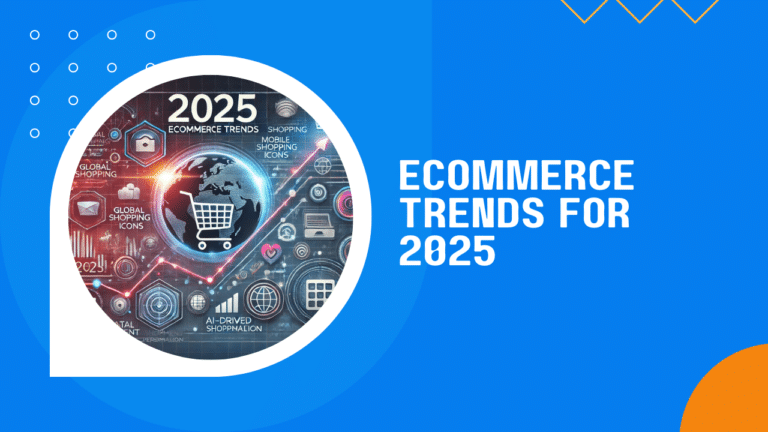The ecommerce landscape is evolving rapidly, with a growth trajectory that shows no signs of slowing down. As digital technologies advance and consumer expectations shift, staying updated with the latest trends becomes essential for businesses aiming to maintain a competitive edge.
In 2025, trends like mobile commerce, AI-driven innovations, personalization, and sustainability are expected to play pivotal roles.
Notably, AI is emerging as a driving force behind many of these changes, reshaping everything from customer service to pricing strategies.
This article explores the key ecommerce trends shaping 2025 and provides actionable insights to help businesses adapt and thrive in the dynamic digital marketplace.
Surge in Mobile Commerce
Mobile commerce is set to dominate the ecommerce sector in 2025, driven by the increasing reliance on smartphones for online shopping. With consumers seeking convenience, the shift toward mobile-first experiences continues to accelerate. Recent projections indicate that mobile commerce could account for over 70% of total ecommerce sales by the end of 2025, underscoring its growing influence.
What is Mobile Commerce?
Mobile commerce, or m-commerce, is the buying and selling of goods and services through mobile devices like smartphones and tablets. It enables users to shop, pay bills, and manage finances directly from their devices, transforming traditional e-commerce by adding accessibility and flexibility. Mobile commerce spans several categories, including mobile shopping, mobile banking, and mobile payments.
Key advancements, like mobile-optimized websites, apps, and secure payment gateways, drive m-commerce, offering consumers convenience and businesses a direct channel to engage customers. The growing adoption of smartphones and mobile internet access has accelerated mobile commerce, making it a central component of modern digital business strategies.
To capitalize on this trend, businesses must focus on developing responsive designs, mobile-friendly interfaces, and seamless mobile payment options. Ensuring a smooth, intuitive mobile experience is critical to boosting conversion rates and enhancing customer satisfaction. Payment methods like digital wallets and contactless solutions further facilitate quicker checkouts, making them essential for mobile optimization.
In short, adopting a mobile-centric strategy is no longer optional for ecommerce businesses aiming to stay competitive—it is vital for capturing a significant share of online sales in the coming year.
AI-Driven Innovations in Ecommerce
Artificial Intelligence (AI) is revolutionizing the ecommerce landscape, reshaping customer interactions, operational processes, and overall business strategies. In 2025, AI’s influence is set to expand even further, playing a critical role in delivering personalized experiences, boosting efficiency, and driving decision-making in real time. Here’s a closer look at how AI is shaping key aspects of ecommerce:
AI-Enhanced Customer Service
AI is enhancing customer support by enabling real-time, efficient, and automated interactions through AI-powered chatbots and virtual assistants. These technologies are becoming more sophisticated in 2025, offering capabilities beyond basic Q&A functions.
- 24/7 customer support: AI chatbots provide around-the-clock assistance, resolving issues and answering questions instantly, improving customer satisfaction and reducing operational costs.
- Sentiment analysis: AI tools can analyze customer sentiment by evaluating language patterns in reviews, chat messages, and social media posts. This enables businesses to identify customer frustrations early, enabling proactive responses that enhance brand reputation.
- Natural language processing (NLP): AI chatbots now understand and respond to complex queries, mimicking human-like conversations. As a result, they can escalate issues appropriately, handle returns, and even offer product recommendations based on prior interactions.
Predictive Analytics for Inventory Management
AI’s application in inventory management is transforming how ecommerce businesses manage their supply chains. By leveraging predictive analytics, AI can forecast demand, optimize stock levels, and anticipate future trends.
- Demand forecasting: AI uses historical data, seasonal trends, and market insights to predict which products are likely to experience spikes in demand. This helps businesses avoid stockouts during peak periods and reduce overstocking during off-peak seasons, leading to lower holding costs and higher efficiency.
- Stock optimization: AI algorithms continuously analyze sales patterns to suggest optimal reorder points, ensuring that inventory is always aligned with current and projected demand. This minimizes waste and enhances supply chain efficiency, leading to cost savings and better resource allocation.
- Automated restocking: AI systems can automate the restocking process by placing orders with suppliers as stock reaches certain thresholds, reducing manual errors and ensuring timely fulfillment.
AI-Optimized Pricing Strategies
Dynamic pricing, driven by AI, is becoming a crucial strategy for maintaining competitiveness and maximizing profitability in the ecommerce market. AI enables real-time pricing adjustments based on various factors like demand, competitor prices, market trends, and consumer behavior.
- Real-time price adjustments: AI continuously monitors competitor prices and adjusts pricing strategies to stay competitive. This dynamic approach allows businesses to offer the best possible prices, which can increase sales while still protecting profit margins.
- Personalized pricing: Some advanced AI systems offer personalized pricing strategies based on customer behavior, purchase history, and perceived willingness to pay, enabling businesses to capture maximum value from each transaction.
- Price elasticity analysis: AI algorithms analyze how different pricing strategies impact sales volumes, helping businesses identify the optimal price point for different products. This analysis can lead to increased profitability without compromising customer satisfaction.
By leveraging AI innovations effectively, ecommerce businesses can create more agile, data-driven strategies that respond swiftly to market changes and customer needs.
Personalization and Customer Experience
Personalization continues to be a defining trend in ecommerce, with advancements in AI and data analytics driving more tailored shopping experiences. In 2025, personalization goes beyond product recommendations; it encompasses the entire customer journey, from marketing to user interfaces and customer service. As consumer expectations for personalized experiences increase, ecommerce businesses must leverage personalization to boost customer engagement, satisfaction, and conversion rates.
AI-Driven Personalized Shopping
AI plays a pivotal role in enhancing personalization by using customer data to create unique shopping experiences. It gathers insights from browsing habits, previous purchases, and even abandoned carts to generate tailored interactions at every touchpoint.
- Product recommendations: AI analyzes user behavior to suggest relevant products, often appearing in the form of “recommended for you” or “customers also bought” sections. These recommendations are not only based on previous purchases but also on patterns derived from similar customer profiles, leading to more accurate suggestions.
- Dynamic user interfaces: AI adjusts website layouts based on individual user preferences. For instance, returning customers may see a homepage that highlights items similar to their previous purchases or items they’ve added to their wishlists. This level of customization not only makes the shopping experience more enjoyable but also reduces the time it takes for users to find what they’re looking for.
- Email and SMS personalization: AI segments customers based on their behavior, allowing ecommerce brands to send personalized marketing messages, offers, and promotions. Research shows that personalized emails have an open rate 29% higher than non-personalized ones, making this a powerful tool for engagement.
Hyper-Personalized Marketing Campaigns
Personalization extends to marketing strategies, where AI helps brands create hyper-targeted campaigns that resonate with specific customer segments.
- Segmentation and targeting: AI divides customers into distinct segments based on their interests, behaviors, and demographics. This enables brands to tailor messaging to each segment, increasing the effectiveness of marketing campaigns. For example, an online apparel store might send promotions based on the user’s preferred style, such as casual wear or formal attire.
- Behavioral triggers: AI systems identify behavioral triggers—such as abandoned carts or items left in wishlists—and respond with personalized follow-up messages. These messages often include incentives like limited-time discounts, which are proven to increase the likelihood of conversion.
- Content personalization: AI-driven content marketing delivers relevant blog posts, videos, and social media content based on users’ previous interactions. For example, if a customer frequently searches for skincare products, they might receive content about skincare routines or product recommendations, driving further engagement.
Enhanced Customer Experience Through Personalization
Personalization not only drives sales but also significantly improves the overall customer experience, making it more engaging and satisfying.
- Faster decision-making: Personalized interfaces, product suggestions, and customer service interactions help customers find what they need quickly, reducing decision fatigue.
- Increased loyalty: Customers are more likely to return to brands that offer a personalized experience. Studies indicate that 80% of consumers are more likely to purchase from a brand that offers personalized experiences, emphasizing the importance of tailoring interactions to boost customer loyalty.
- Reduced returns: By offering more accurate product recommendations and detailed product information, personalization can also help reduce return rates. AI tools that suggest sizing, color preferences, or complementary products enhance the likelihood of correct purchases, minimizing the chances of dissatisfaction.
Data-Driven Personalization Strategies
As ecommerce companies seek to implement personalization at scale, they need to focus on data collection and analytics to understand customer behavior better.
- Real-time data processing: AI tools process customer data in real time, allowing businesses to offer relevant suggestions and personalized content without delays.
- Customer feedback integration: AI analyzes feedback from reviews, surveys, and support interactions to refine personalization strategies. For example, if customers frequently mention specific issues with a product, AI systems can prioritize this feedback in future interactions to address customer needs proactively.
- Cross-channel personalization: To create a cohesive experience, ecommerce brands are integrating personalization across multiple channels, including websites, mobile apps, email campaigns, and social media. This ensures a seamless experience regardless of where the customer interacts with the brand.
Businesses can deliver increasingly tailored experiences that not only meet but exceed customer expectations.
Growth of Social Commerce
Social commerce is rapidly emerging as a powerful force in the ecommerce landscape, enabling seamless shopping experiences directly within social media platforms. In 2025, social media’s role in driving ecommerce sales is expected to grow further, fueled by increasing consumer engagement, enhanced targeting algorithms, and integrated shopping features. As social platforms evolve, ecommerce businesses must leverage social commerce to capture a wider audience and drive conversions.
Influence of Social Media Platforms
Social media platforms like Instagram, TikTok, Facebook, and Pinterest are becoming more than just marketing channels; they are evolving into full-fledged sales channels.
- Native shopping features: Platforms like Instagram and TikTok have integrated native shopping features that allow users to discover, explore, and purchase products without leaving the app. Instagram’s “Shop” tab and TikTok’s “Shop Now” buttons make it easy for users to browse and buy products directly within the app. This streamlined experience reduces friction and simplifies the path to purchase, boosting conversion rates.
- Live shopping events: Live shopping, popularized by platforms like TikTok and Facebook, combines social interaction with real-time product demonstrations. This format allows brands to showcase their products, engage with audiences through Q&A sessions, and offer exclusive discounts, all in a live setting. Live shopping events are projected to increase customer engagement by 30%, making them a crucial part of social commerce strategies in 2025.
- Shoppable posts and videos: Platforms like Pinterest and YouTube offer shoppable content that allows users to click directly on products featured in posts or videos, leading to instant purchase options. This seamless integration makes discovering and buying products intuitive, resulting in higher engagement and sales.
The Role of Influencer Marketing
Influencer marketing continues to drive social commerce, with influencers acting as trusted voices that influence consumer behavior and purchase decisions.
- Authentic product endorsements: Influencers create authentic content that resonates with their followers, making product recommendations feel more personal and trustworthy. In 2025, influencers are expected to drive over 60% of social commerce sales, emphasizing the importance of collaborating with creators who align with a brand’s target audience.
- Affiliate marketing: Influencers often use affiliate links that direct users to ecommerce sites, but with the growth of social commerce, many influencers can now facilitate in-app purchases directly through their social media content. This seamless process allows brands to track sales and conversions more effectively while leveraging influencer credibility.
- Micro-influencers: In addition to top-tier influencers, brands are increasingly working with micro-influencers, who typically have engagement rates up to 60% higher than macro-influencers. Micro-influencers often have highly engaged, niche audiences, making them ideal for targeted social commerce campaigns.
User-Generated Content (UGC) as a Sales Driver
User-generated content (UGC) plays a significant role in social commerce by creating authentic, relatable endorsements that drive sales.
- Social proof: UGC, such as customer photos, reviews, and testimonials, serves as social proof that validates product quality and user satisfaction. Consumers are more likely to trust content generated by fellow customers, making it a powerful driver of conversions. Studies show that 79% of people say UGC highly influences their purchasing decisions.
- Shoppable UGC galleries: Many ecommerce brands integrate shoppable UGC galleries on their websites and social media pages, allowing customers to see how others have styled or used products. This inspires new buyers and simplifies the path to purchase by providing a direct link to the product page.
- Hashtag campaigns: Brands encourage customers to share photos and experiences using specific hashtags. This not only promotes engagement but also generates valuable UGC that can be repurposed across social platforms, enhancing brand credibility and reach.
AI Integration in Social Commerce
Artificial Intelligence (AI) enhances social commerce by enabling better targeting, personalization, and engagement.
- Advanced targeting algorithms: AI algorithms analyze user behavior, demographics, and preferences to deliver highly targeted ads and shoppable posts. This ensures that users see relevant products, increasing the likelihood of engagement and conversion.
- Chatbots for social commerce: AI-powered chatbots integrated with social media platforms can guide customers through the purchase process, answer questions, and provide product recommendations in real-time. This creates a seamless shopping experience within the app.
- Visual search: AI-powered visual search features enable users to search for products by uploading images. For instance, Pinterest’s visual search tool allows users to discover similar products simply by uploading a photo, making product discovery faster and more intuitive.
Examples of Successful Social Commerce Strategies
Many brands have effectively utilized social commerce to increase engagement and drive sales:
- Fashion Nova: Known for its strong presence on Instagram, Fashion Nova uses shoppable posts, UGC, and influencer collaborations to drive a significant portion of its sales directly through the platform.
- Sephora: Sephora uses a combination of shoppable content, live shopping events, and influencer marketing across platforms like Instagram and TikTok to create a seamless social commerce experience.
- Gymshark: Gymshark leverages UGC, influencer partnerships, and live workouts on social media to engage with its community and drive sales, making it one of the leading brands in social commerce.
As social media platforms continue to evolve, ecommerce businesses must adapt to this trend to remain competitive and capture a growing share of online sales.
Emphasis on Sustainability
Sustainability is becoming a crucial factor for ecommerce brands, as consumers increasingly prioritize eco-friendly products and ethical practices in their purchasing decisions. In 2025, the demand for sustainable ecommerce will continue to rise, driven by growing environmental awareness and a desire for responsible consumption. Ecommerce businesses are not only adopting sustainable products but also integrating green practices across their supply chains to meet this demand.
Consumer Demand for Eco-Friendly Products
Sustainability is no longer a niche preference; it has become a major consideration for a broad range of consumers.
- Rising consumer awareness: Studies indicate that over 70% of consumers are willing to pay more for sustainable products, demonstrating a strong willingness to support brands that align with their values. This trend spans across industries, from fashion to electronics, with customers actively seeking products labeled as organic, recyclable, or ethically sourced.
- Product transparency: Consumers are looking for transparency regarding the environmental impact of the products they purchase. Brands that offer detailed information about the sourcing of materials, manufacturing processes, and carbon footprint gain a competitive advantage. For instance, brands like Patagonia and Allbirds highlight their sustainable practices prominently, attracting eco-conscious consumers.
- Preference for sustainable packaging: With growing concerns about plastic waste, sustainable packaging has become a key factor in purchasing decisions. Consumers prefer brands that use biodegradable, recyclable, or reusable packaging, prompting many ecommerce businesses to shift away from single-use plastics.
Adoption of Sustainable Practices in Ecommerce
Ecommerce companies are implementing various sustainable practices to reduce their environmental impact and meet consumer expectations.
- Carbon-neutral shipping: To address the carbon emissions associated with shipping, many ecommerce brands now offer carbon-neutral delivery options. Companies partner with third-party organizations to offset emissions through reforestation projects or renewable energy initiatives. For example, Shopify’s Planet app enables businesses to calculate their shipping emissions and offset them with sustainable projects.
- Reduced packaging waste: Ecommerce brands are redesigning their packaging to minimize waste, using smaller boxes, less filler, and recyclable materials. Brands like Amazon and Grove Collaborative have introduced “frustration-free packaging” that reduces excess packaging and uses fully recyclable materials.
- Circular economy initiatives: The circular economy model is gaining traction in ecommerce, with brands encouraging practices like recycling, refurbishing, and resale. For example, ThredUp and Poshmark promote second-hand fashion, while brands like IKEA offer furniture buy-back programs, emphasizing product reuse rather than disposal.
Eco-Friendly Products and Materials
In addition to adopting sustainable practices, ecommerce brands are increasingly offering eco-friendly products made from sustainable materials.
- Ethical sourcing: Brands are prioritizing materials that are ethically sourced, such as organic cotton, recycled fabrics, or sustainable wood. For instance, brands like Reformation and Everlane focus on transparency regarding their material sourcing and production methods, appealing to consumers seeking ethically made products.
- Biodegradable products: Many ecommerce companies are introducing biodegradable versions of popular products, from household cleaners to packaging materials. Biodegradable alternatives not only reduce waste but also cater to consumers who wish to minimize their ecological footprint.
- Vegan and cruelty-free products: The demand for vegan and cruelty-free products continues to grow in sectors like fashion, beauty, and food. Brands that clearly label their products as vegan or cruelty-free often attract consumers who are looking to make ethical choices aligned with sustainability.
The Business Case for Sustainability
Adopting sustainable practices is not only good for the planet but also beneficial for ecommerce businesses in terms of brand loyalty, customer retention, and market growth.
- Increased customer loyalty: Brands that consistently demonstrate commitment to sustainability often enjoy higher customer loyalty. Consumers are more likely to return to and support brands that share their environmental values, resulting in longer customer lifecycles and stronger brand advocacy.
- Higher conversion rates: Sustainable practices can positively impact conversion rates. According to recent studies, 67% of consumers consider sustainability a key factor in their purchasing decisions, making it a vital aspect of ecommerce strategy.
- Reduced operational costs: Sustainable practices, such as reducing packaging materials or implementing energy-efficient logistics, can also lower operational costs. For example, using smaller, lighter packaging can reduce shipping costs while minimizing environmental impact.
Examples of Ecommerce Brands Leading in Sustainability
Several ecommerce brands have successfully integrated sustainability into their business models, setting a strong example for the industry.
- Patagonia: Renowned for its environmental activism, Patagonia emphasizes eco-friendly materials, transparent sourcing, and recycling initiatives. It even encourages customers to repair and reuse products rather than replace them.
- Allbirds: Allbirds uses sustainable materials like merino wool, recycled plastic, and sugarcane in its footwear, positioning itself as a leader in eco-friendly fashion.
- The Body Shop: This beauty brand focuses on ethical sourcing, cruelty-free products, and recyclable packaging, all while advocating for social and environmental causes.
As sustainability becomes an integral part of ecommerce strategy, brands that prioritize ethical practices are likely to enjoy increased consumer trust, loyalty, and long-term success.
Conclusion
Ecommerce in 2025 is defined by rapid technological advancements, evolving consumer preferences, and a strong emphasis on personalization and sustainability. From the rise of mobile commerce and AI-driven innovations to the integration of augmented reality, social commerce, and advanced payment technologies, the trends discussed here represent critical opportunities for growth and adaptation in the ecommerce sector.
AI emerges as a central force, driving personalization, efficiency, and innovation across various aspects of ecommerce, including customer service, inventory management, and pricing strategies. Meanwhile, sustainability is no longer optional but essential, with consumers actively seeking eco-friendly products and transparent practices from brands.
To remain competitive, ecommerce businesses must embrace these trends and experiment with new technologies to enhance customer experience, improve operational efficiency, and increase sales. As the digital marketplace becomes increasingly dynamic, proactive adoption of these strategies will be vital for building stronger customer relationships and achieving long-term success.
Now is the time for ecommerce brands to assess their current strategies, incorporate these emerging trends, and invest in technologies that ensure agility, security, and a customer-centric approach.









